Strawberries are delicious. They are packed with nutrition. And it is not just humans that love to eat them.
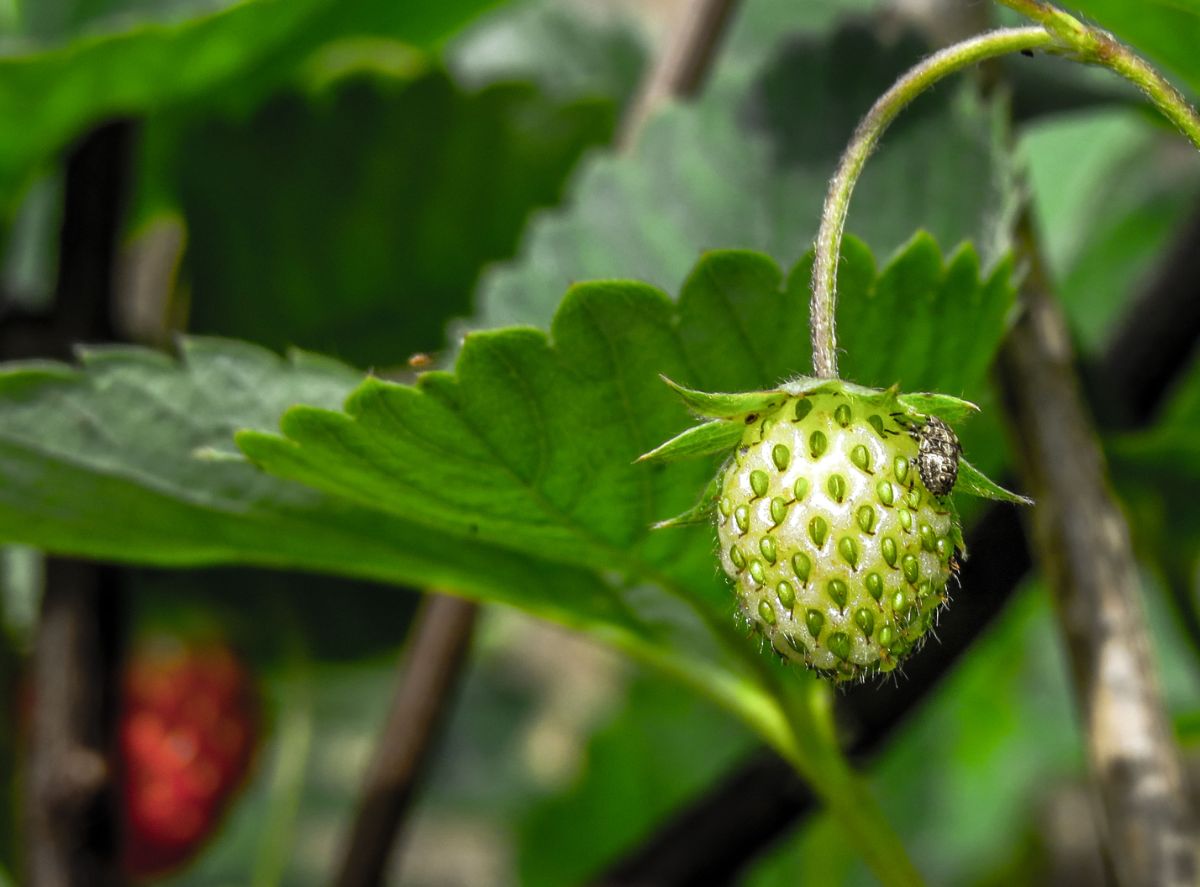
Whether your strawberry fields are large or small, birds, insects, and other pests will compete for your crop. In this article we will give you some simple suggestions for letting our animal friends find other sources of sustenance and keeping your strawberries for yourself. I published another article talking about beneficial bugs and pests and how to attract them for a healthy strawberry garden.
Jump to:
- How to Keep Birds Away from Your Strawberries
- How to Deal with Insects in Your Strawberry Plantings
- Meet the Fruit Fly
- What Can You Do About Fruit Flies?
- Tarnished Plant Bugs
- Thrips – Devastating Strawberry Pests
- How to Deter Slugs and Snails
- Rodent Control for Strawberry Growers
- Deterring Theft of Strawberries
How to Keep Birds Away from Your Strawberries
Dozens of species of birds feed on strawberries, although some birds are pickier eaters than others.
Crows prefer larger fruit, such as apples, but they will also take a bite out of strawberries. Crows seldom eat a whole berry. They take a single peck at a strawberry and leave the rest for insects and rodents.
Grackles eat small strawberries whole, but they may just slash larger berries.
House finches and house sparrows peck holes in strawberries that leave the fruit susceptible to decay.
Robins eat strawberries whole. They can do substantial damage to a small bed of strawberries.
Starlings can do massive damage to strawberry beds in home gardens. They descend in flocks and eat everything they can find. They eat smaller fruit whole and peck out the interiors of larger strawberries.
[amazon box=”B096NCJHBD,B07MD5KF83,B09N2ZY835,B01N6970MN,B01LYEI23V” grid=”2″]
Although birds will eat strawberries anywhere they are planted, the damage is greater in urban gardens than on farms. Bird damage is greater in a home gardener’s bed of strawberries than in a farmer’s field of strawberries.
For strawberries grown commercially, bird damage is usually insignificant. A group of scientists at the University of California at Davis, the University of Kentucky, and the University of California at Berkeley did a controlled study of bird damage to commercial strawberry fields. They found that birds typically ate about 3 to 4 percent of a strawberry crop and that fecal contamination from birds only affected about 0.01 percent of the crop.
In the interior of a commercial field, birds ate more insects than strawberries. In the periphery of the strawberry field, the presence of birds is a net positive. It is only around the edges of a farmer’s strawberry field that bird damage outweighed bird benefits.
Home gardeners experience a different story. Birds can ruin a home gardener’s entire crop. But there are things both home gardeners and commercial growers can do to keep bird damage to a minimum.
For home strawberry beds, the solution is to protect the strawberries with a bird-resistant cloth. Pick up some 1 x 1 wooden decking pieces (that’s 25 mm x 25 mm) at your neighborhood home improvement center or lumber yard. Use the decking pieces to build a structure like a table long and wide enough to cover your entire strawberry bed, and tall enough to accommodate your tallest plants. Make a “table,” not a “box,” so there is no lower edge to crush them. Tack mesh cloth over the box on five sides, leaving the bottom open. Then just place the box over your strawberries and lift it up to harvest.
This structure can also be used to protect other plants when your strawberries are not fruiting.
If you are growing strawberries commercially, there are two secrets to protecting your field from birds:
- Have all of your strawberries in a single, continuous field. The larger your field, the more protected your plants in its center.
- Remove bird habitat around your strawberry field. Don’t leave bushes, bird houses, or shrubbery around your strawberry plants.
Think twice before declaring war on birds that eat your strawberries. Many towns and cities are bird sanctuaries. It is always illegal to kill birds in these locations. Poisons don’t discriminate between species. If you put out poison for a species it is lawful to kill, such as a grackle, but a protected species eats the poisoned bait and dies, you may be guilty of a state or federal crime. Even if birds are swooping down and swarming your crop, you may need to apply for a Migratory Bird Depredation Permit that can be obtained from the U.S. Fish and Wildlife Service (FWS) to take care of large numbers of birds with lethal methods.
Non-toxic, non-lethal methods are better for controlling birds on commercial fields. There are two major types:
- Visual scare devices. These include spinners, streamers, plastic snake and plastic owl models, aluminum pie pans, and scare-eyes (balloons with eyes painted on them). Birds can become accustomed to visual deterrents, so it’s necessary to use varying types and colors placed in varying locations to keep birds from becoming accustomed to them.
- Noisemakers. Noisemakers for bird deterrence include sirens, cannons, and exploders. Noisemakers work best when they are applied at irregular intervals. If you use noisemakers at the same time every day, birds will become accustomed to them. Tapes of bird distress calls are more effective than generic sources of noise, but it is necessary to obtain tapes of the specific kinds of birds causing damage. If you use noisemakers too often, birds will become accustomed to them.
You can also try tricking the birds by painting strawberry-shaped rocks to look like strawberries and then evenly distributing them throughout your strawberry plants. The bright red will attract your local avian thieves to the location looking for some free food. Fortunately, a few pecks will prove the ruse and foil the birds’ plans.
Not wishing to be duped continuously, they will soon learn that the “strawberries” that their brain says should be delicious are actually quite inedible. Once the lesson has been learned, they will leave your strawberry bed alone. As long as the strawberry rocks are painted well in advance of the time your plants actually start setting their real fruits and aren’t obscured by your growing strawberry plants, the birds will remember your first trick and fall hook-line-and-sinker for your second by leaving the fresh fruit alone and in full view! A step-by-step tutorial has been created by Lee Wismer. It can be accessed here: Strawberry Rocks Tutorial. When cabin fever sets in this winter, prepare this “home remedy” with the children or grandchildren. Then, deploy it when the strawberry plants exit dormancy in the spring! Good luck!
There is a chemical called methyl anthranilate that tastes bad to birds but is tasteless for humans. It may not be legal where you live, and it cannot be used in organic strawberry production. Sometimes it burns the leaves of plants on which it is sprayed.
And sometimes the secret to keeping birds out of your strawberry patch is changing varieties. Planting Alpine Gold strawberries, which are yellow when ripe, may fool birds looking for red strawberries.
How to Deal with Insects in Your Strawberry Plantings
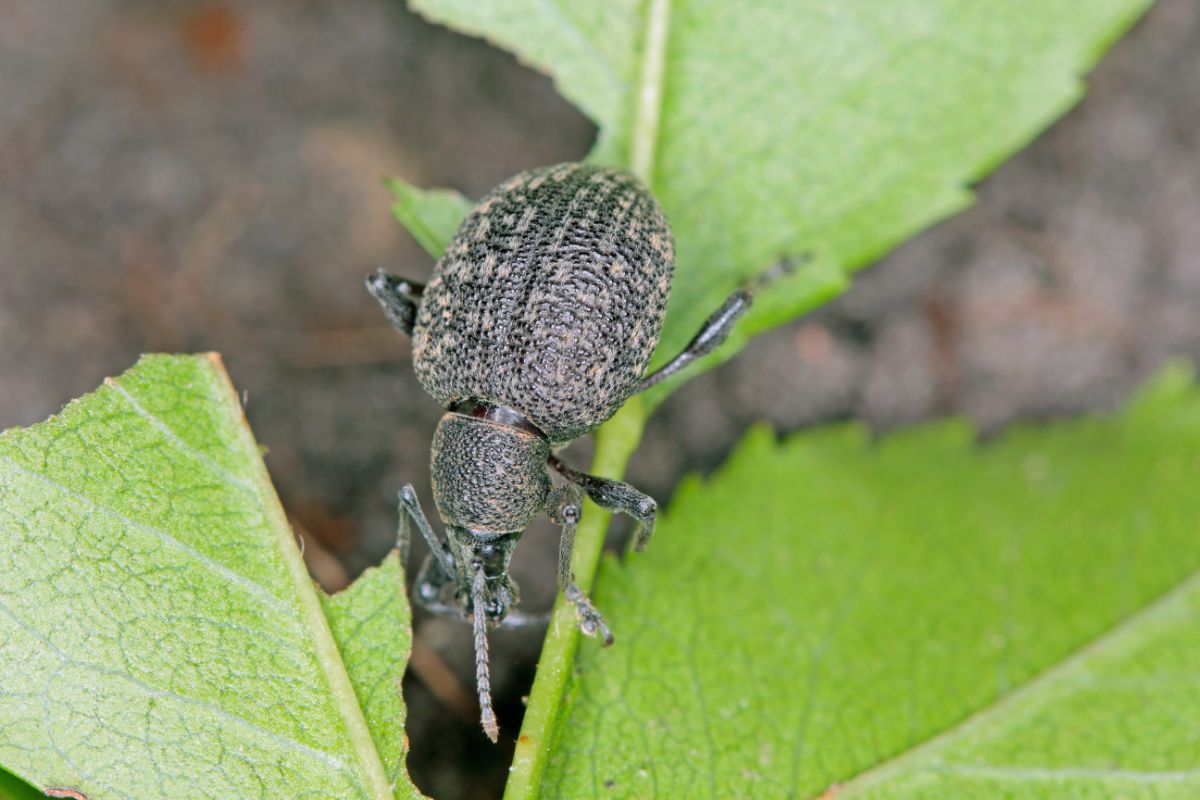
Everything about bugs in your strawberry patch isn’t bad. One of the reasons strawberries are so nutritious is their content of a group of plant chemicals known as polyphenols. These plant chemicals include anthocyanins, ellagitannins, and proanthocyanidins that give strawberries their bright red color and also support human health. These are the plant chemicals that have anti-aging qualities.
Strawberries make polyphenols to protect their seeds (those tiny dots on the surface of a strawberry) after insects bite their leaves. It is as if the plant knows that its seeds are endangered so it wants to make the chemicals that extend their lives in case part of the berry is consumed. Scientists have also discovered that strawberries harvested from plants that have undergone mechanical wounding (simulating insect stress) are sweeter and contain more beneficial polyphenoles. That’s probably part of why organic strawberries are brighter and tastier than conventionally raised strawberries.
So what kinds of insects do the most damage to strawberry crops? Some potential pests include:
- Crickets feed on leaves. They usually do only minor damage. They may trigger the production of polyphenols and sugars that improve strawberry quality.
- Cutworms feed on leaves and stems. Because injury to a stem can kill fruit, cutworms need to be controlled.
- Cyclamen mites feed in the crown. Because they can kill the entire plant, they have to be controlled.
- Flower thrips feed on flowers and young fruit. Because they destroy strawberries, they have to be controlled.
- Red imported fire ants are a general nuisance. Fire ant deterrence is always desirable.
- Sap beetles feed on overripe fruit. You can help keep sap beetles under control by timely harvests and by not leaving overripe fruit in your strawberry planting.
- Twospotted spider mites feed on leaves. They also may trigger reactions in the plant that increase strawberry quality if they are not allowed to multiply into numbers that strip the plant bare of its leaves.
- Whiteflies feed on leaves. When they are not superabundant, they actually improve quality of fruit.
If you are a commercial grower of strawberries, you should consult with your local extension agent about specific treatments that can protect your crop against insects. Your extension agent will have detailed knowledge of agricultural chemicals most likely to work in your local conditions, as well as organic methods of insect control. But no matter whether you have a just garden bed of strawberries or a 100-acre field, you need to protect your crop from fruit flies.
Meet the Fruit Fly
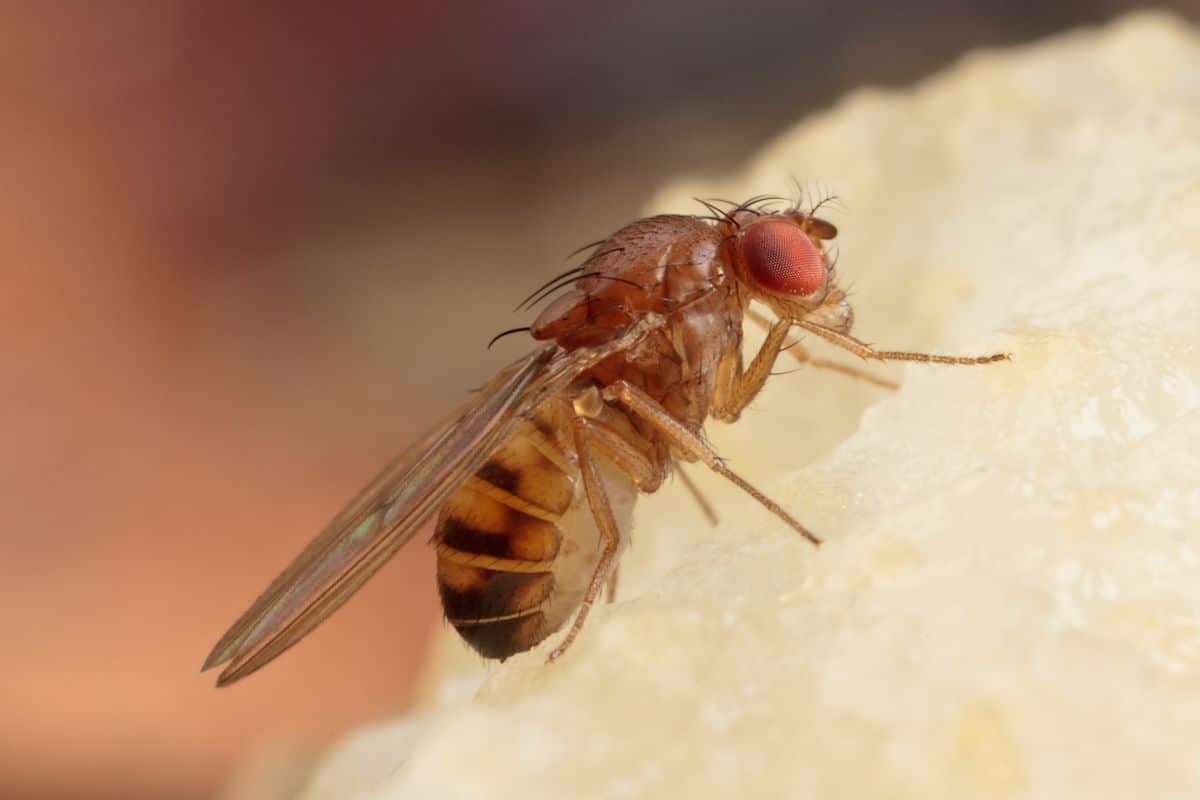
Fruit flies, as their name suggests, feed on fruit and berries. They can feed on fresh fruit and spoiled fruit, and they also love strawberries.
What’s the big deal about fruit flies?
Fruit flies can inject their eggs into strawberries. The eggs hatch into tiny larvae that wriggle out of the berry to feed on mold and fungus. The larvae are especially tasty to cockroaches, which are attracted to strawberries you allow to go bad.
Fruit flies eat fruit for energy, but the females need protein to make their eggs. They usually get their protein from animal dung and any kind of decaying flesh. They are attracted to the scent of ammonia. They can transfer E. coli and Salmonella from dung to your strawberries. They can inject their eggs into the berry without leaving a detectable trace.
What Can You Do About Fruit Flies?
Fruit flies are relatively long-lived as flies go, buzzing around your strawberries for 30 to 40 days if you don’t do something about them. So do something about them:
- Small infestations of fruit flies can be controlled with easy, inorganic methods that cost almost nothing at all. You can put about a quarter of a cup of vinegar in dish and add a few drops of dish soap. Fruit flies will be attracted to the vinegar but will not be able to fly out because of the soap. Or you can place rotting fruit in a jar, collect the fruit flies that gather to consume it, and dispose of fruit and flies inside plastic wrap into the trash. If you prefer an organic approach, you can make a fruit fly trap with any essential oil containing a compound called eugenol. This chemical is a fruit fly attractant that can lure them into soapy water or candles. Essential oils that are rich in eugenol include oils of artemisia, cinnamon, galangal root, and hyssop.
- Fruit fly problems for commercial strawberry growers can also be solved with non-toxic methods. There are fruit fly “zappers” Lumnia brand. These fruit fly killers have a subdued design that make them suitable for use even in public spaces without calling attention to a fruit fly problem. They require no chemicals and leave a minimal environmental footprint. Most importantly, they keep dead fruit flies out of public view after they have been “zapped.”
- Chemical control of fruit flies works, but there are significant risks for fish, birds, pets, and people. Don’t use chemical control without consulting an expert, such as your county extension agent. An extension agent’s advice is free.
Tarnished Plant Bugs
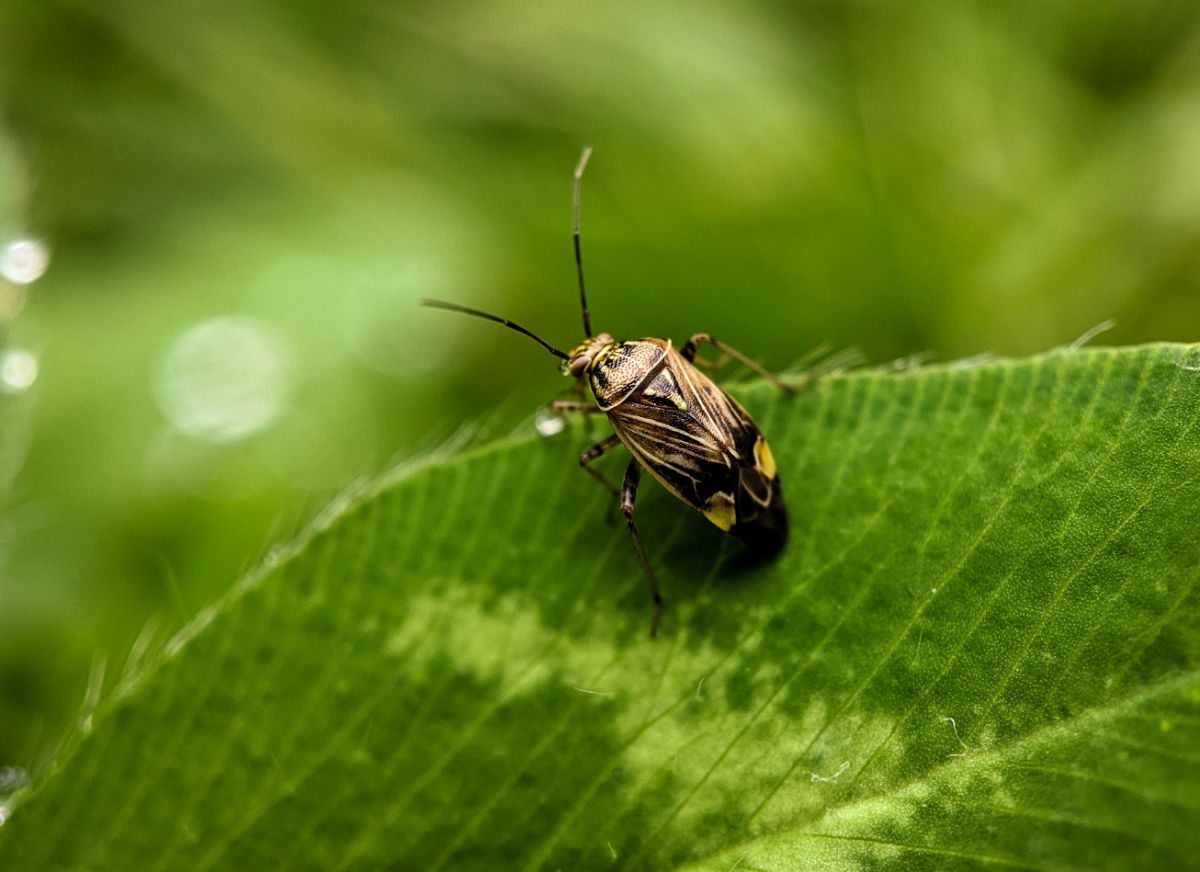
One of the most maddening pests is the tarnished plant bug (TPB). TPBs are the bane of farmers who grow small fruits and vegetables, including strawberry growers. The bugs are tremendously resilient. In an attempt to kill them off, farmers will often apply insecticides three to five times per year. All these insecticides may be necessary for commercial operations, but home gardeners may be able to avoid such measures.
The most infuriating aspect of a TPB infestation is the damage done to strawberries. Tarnished plant bug nymphs will inject a growing strawberry seed with a toxin. At the point of injection, the strawberry fruit will stop developing. This will result in a “nubbin.” Nubbins are one of the common types of deformed strawberries where there is a seed-packed brown tip to the strawberry and a halted development of the flesh.
How to Kill Tarnished Plant Bugs
It isn’t easy. As mentioned above, great quantities of insecticide are required to get rid of these monsters. The best plan of action is to keep them out of your garden in the first place. Sprinkling diatomaceous earth may help keep them at bay. Also, since TPBs thrive in alfalfa, avoid mowing alfalfa while your strawberry plants are blooming.
In the future, there may be a fungal method of TPB control. The University of Vermont Entomology Laboratory is currently performing research on controlling insects with fungi. Should they be successful in isolating a fungus that will kill tarnished plant bugs, the world will be a better place for strawberry gardeners.
Thrips – Devastating Strawberry Pests

Thrips and strawberry plants simply don’t go well together. Thrips are one of the devastating strawberry pests that afflict strawberry plantings and enrage gardeners. If you are having difficulties with “something” damaging your strawberries, it just might be this common pest.
The thrips are small. They can range from 0.5 millimeters to 14 millimeters in length, but the average length is just over one millimeter (1/25 of an inch). See the picture below for a scanning electron micrograph of a thrip.
Strawberries that have white discoloration on the berry’s surface or golden-brown discoloration often are the result of damage done by thrips. Strawberries contorted into odd, folded shapes (cat facing) often indicate thrips have been feeding as well. When thrips feed on the strawberry flowers, poor quality fruit is usually the result.
Thrips can do damage during most of the season. However, their populations tend to increase rapidly during the mid-to-late summer.
Thrips will do damage to any type of strawberry plant. However, since everbearing strawberries tend to produce a significant crop later in the season, and since thrip populations boom during the mid- to late summer, they are more affected than are June-bearers.
The bottom line is that thrips are bad news. If you see bugs like the one above, it is likely that your strawberry plants are going to be food for the creepy crawlies.
How to Deter Slugs and Snails
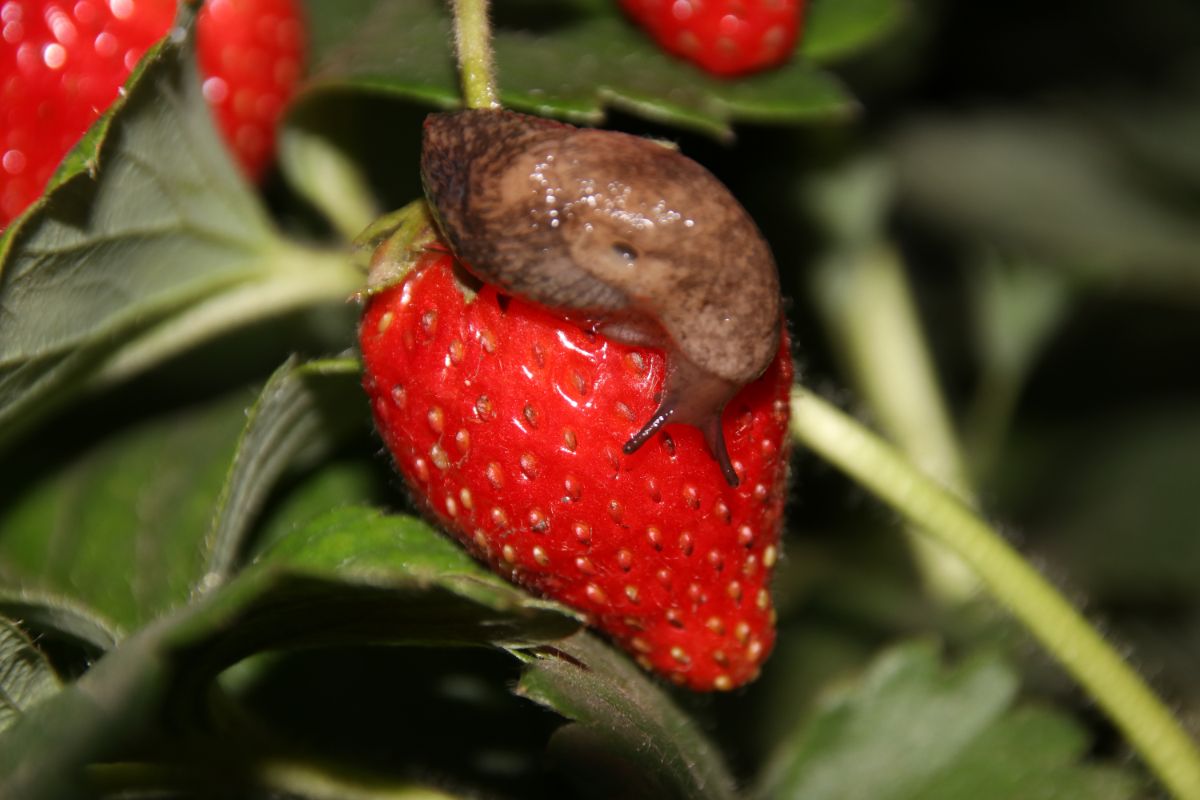
Slugs and snails also feed on flowers and fruit. They have to be controlled to preserve the crop.
Slugs are snails without shells. Both slugs and snails dine on strawberries with gusto, especially in relatively cool and moist climates such as those in New England and the Pacific Northwest. Here are some simple methods of slug and snail control.
- Snails only eat healthy plant matter when decaying plant matter is not available. Be sure to remove any overripe strawberries before snails and slugs find them.
- Pouring salt on a slug will kill it, but salt isn’t good for your strawberries, either.
- You can provide slugs with an edible hotel. Place the peels from grapefruit halves or large cabbage leaves on the ground, allow slugs to start eating them, and then collect the peel or leaves with the slugs and throw both in the trash.
- Snails survive hot spells by climbing tall plants. Be sure to pull any weeds around your strawberry plantings to deprive them of shelter near your crop.
- Spray plants with a diluted mixture of essential oil of thyme in water (about 50 parts of water to one part of essential oil) just before sundown to discourage slugs and snails from eating them.
- Pick snails and slugs by hand and remove them from your property. You will have to work at night with a flashlight but it is a highly effective method that requires no poisons and zero expense.
- Put up a barrier such as Snail-Gard around your strawberry bed to keep out snails and slugs. The vertical copper barrier needs to be at least 4 inches (10 cm) tall, half of it underground so snails and slugs won’t burrow under it. A copper barrier will protect your strawberry bed from snails and slugs for several years.
There’s a popular insecticide called metaldehyde, which comes as blue pellets, that is effective at killing snails and slugs. The problem with the product is that is repels not just snails and slugs but also people. It has to be scattered around to be effective. You can’t just dump the blue pellets around the edges of your strawberry patch and expect to get good results.
Rodent Control for Strawberry Growers
Rats and mice love strawberries, too. Fortunately, most rodents live within a small area, never wandering more than about 100 feet from where they were born. If you can eliminate rodent habits around your strawberry plants, you won’t have a problem with rats and mice that steal your crop.
Eliminate rodent habitat by clearing tall grass and brush within 50 feet of your plantings. Make sure grass around your garden or field stays trimmed during the growing season and before the first frost.
Never let boards, firewood, or trash accumulate around your garden or field. And never let your strawberries be overrun by weeds.
Deterring Theft of Strawberries
There is one more animal that can decimate your strawberry crop. That’s humans. It’s not unusual for home gardeners to lose their strawberry crops to theft.
What can you do to deter the theft of your strawberries? Some of the same methods that work on birds and rodents also deter theft.
A plastic snake in your strawberry bed can capture a would-be thief’s attention. So can a noise cannon that goes off at random times when you are not at home to keep tabs on your strawberry patch.
Or if you are up for telling a white lie, you could post a sign warning would-be thieves that you just treated your strawberry patch with a toxic, carcinogenic product like Chlordane to kill insects (without actually using Chlordane, of course) and toss a few mothballs out in your strawberry patch to give the area of an appropriately toxic smell. The mothballs will also deter squirrels.
It isn’t necessary to kill pests to protect your strawberry crop. Diligent pest control can preserve your strawberry crop and let Nature take care of birds, bugs, and other pests.

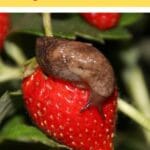
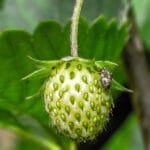
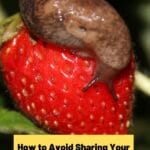
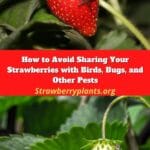
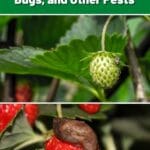




Gale Teschendorf says
My strawberries are attacked by tiny ants.
Mary Ward says
Try using diatomaceous earth to sprinkle on and around them. But don’t sprinkle while they are flowering so you don’t kill pollinating bees.
Ground cinnamon around the plants is also an ant repellent. Beekeepers often use this around their hives to deter ants.
Paul says
Hi Penny, if your plants are planted into the ground, then put some grass cuttings under the leaves and fruit to keep them off the soil. If you have them on plastic plant bags, fold the top rim of the bag in under the flowers and fruit to keep them off the soil. I hope this will help foe you as it does for me. Regards, Paul.
Joelle says
Can you please help me, its seems the blow flies are attracted to my strawberries soooo annoying I have them covered under a mesh tunnel but the dam blow flies still seem to find thea way in their.
Any help will be greatly appreciated.
Thanks
Shawna says
Wonderful information all in one place. Thankyou for providing this information and sharing with others
Penny says
My plants are just now starting to berry but the plant is very close or laying on the ground. Is it ok to prop them up? If so, what is the best prop to use? I put some string around the bunches of leaves of the plant. ?? I am in S.E. Alaska and we have had a lot of sun and warm weather which is breaking temperature records for this area.
Recto Puno says
The article is informative but I did not see any recommendation on how to control thrips.
Any recommendations?
Thanks.